Sourdough Olive Bread
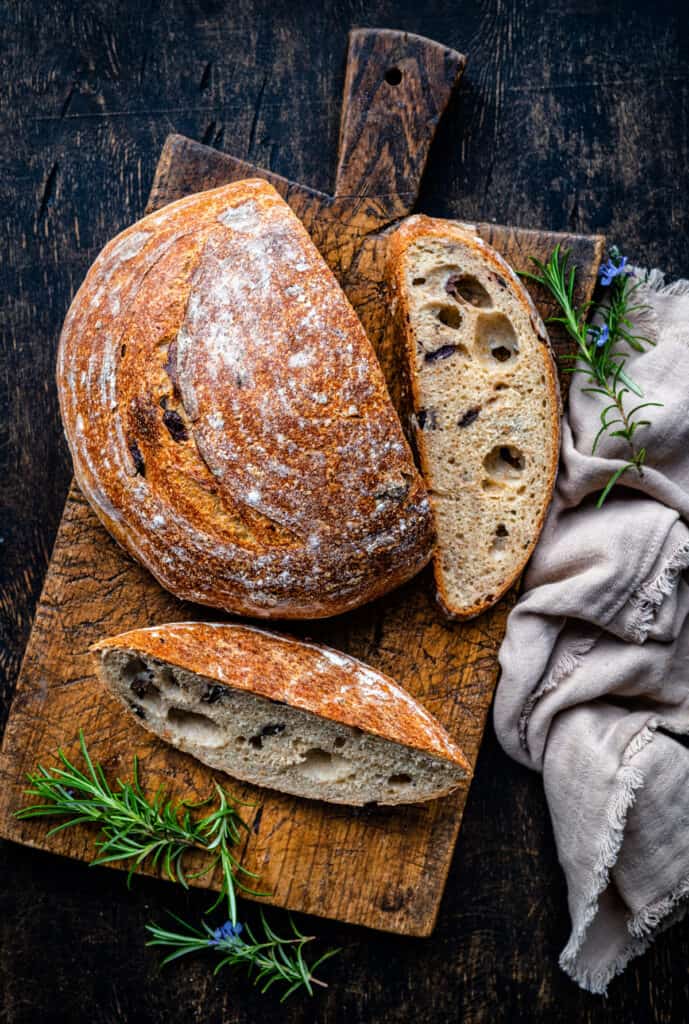
This delicious Sourdough Olive Bread is so easy to make! Just mix the dough, rest overnight, shape and bake. This no knead sourdough bread studded with olives and rosemary is perfect for beginners.
Ingredients
Starter (Levain)
- 60 g (¼ cup) mature starter room temperature
- 60 g (¼ cup) white bread flour
- 60 g (¼ cup) tepid water (filtered, bottled or boiled and cooled tap water)
Olive Sourdough
- 150 g ripe levain (all of the starter you prepared earlier)
- 300 g (1 ¼ cups) water (filtered, bottled or boiled and cooled tap water)
- 400 g (3 ¼ cups) white bread flour plus extra for dusting
- 100 g (1 cup) dark rye flour or you can use wholemeal
- 12 g (2 tsp) sea salt
- ½ tbsp sugar (optional)
- 60 g (⅓ cup) diced black olives Kalamata olives
- 2 tbsp fresh rosemary leaves finely diced
Instructions
Prepare your starter (levain)
-
Feed 60g of active starter with 60g flour and 60g lukewarm water. Leave for 4-6 hours until doubled in size, bubbly and floating in water (float test).
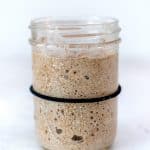
Prepare The Bread Dough
-
Add 150g of bubbly starter in a large mixing bowl. Pour in 300g of water and mix well.
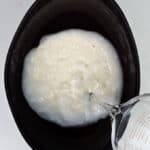
-
Add the rye and white bread flour, salt and sugar and mix well with the dough whisk or your hands. It’s easier to have a feel for the dough if you use your hands. You will have a shaggy, slightly sticky dough.
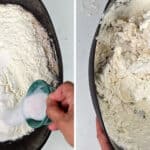
-
Transfer the dough into a rectangular container (I like a glass pyrex dish), cover and leave to rise at a COOL room temperature overnight (8-10 hours) or in the fridge for 12+ hours.
Shape The Sourdough
-
-
If you have used the cold rise method (in fridge) allow the dough to come to room temperature before shaping.
Tip the dough onto your kitchen worktop – no need to add flour. Gently stretch to a rectangle shape, doing so gradually so as not to tear the dough if possible.

-
-
Fold the dough into three sections (letter fold). Pick up one of the sides of your dough and fold it a third of the way over. Now fold the other side over the top, as you would a letter.

-
Roll the dough into a tight ball and flip over seam side down. Use your hands to shape the loaf into a spherical shape, sprinkling with a little flour as you do.

-
Flip over, seam side down, and shape into a round loaf (known as a “boule”). Use your hands and a bench scraper to roll the loaf in your hands, slightly tucking the edges under as you go (please check the video for a demo).
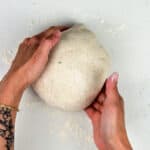
Second Rise
-
Cup the loaf into your hands and put into a prepared banneton, with the seam side up. Cover loosely with a towel or a bag and leave in a warm spot to rise for 1-2 hours or until it springs back slowly when prodded. The temperature in your house will dictate how long it will take for your dough to prove.

-
Preheat your oven to 450F (230C) at least 45 minutes before the end of proving. Place a lidded pot (Dutch Oven) in the oven to preheat. Tip the loaf onto parchment paper and score the top using a sharp knife, razor or lame.
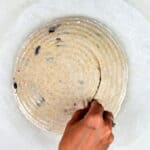
Bake your Sourdough
-
-
Remove the pot from the oven using pot holders (please be very careful as it can easily give you very bad burns, as I can testify). Carefully place the dough into the pot, lifting it by the baking paper.

-
-
Cover and bake for 20 minutes. Reduce the temperature to 425F (220C). Take the lid off the pot and cook for another 20-25 minutes. You can lift the bread out of the pot and cook directly on the oven shelf for the final 5 minutes. Cool the bread on a wire rack for at least an hour before slicing.

Notes
Carefully transfer your load seam side up in this case. Cover with a bag and leave to rise. When the dough is ready to bake, after the second rise, carefully invert onto baking paper then proceed to bake in a Dutch Oven.
Storing Sourdough BreadCover the cooled loaf in a clean tea towel and store at room temperature – the bread will keep for 2-3 days.
I prefer to slice the entire loaf and then freeze it – that way you can toast slices directly from frozen whenever the fancy takes you.


